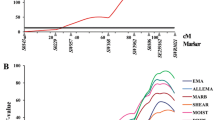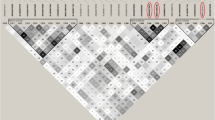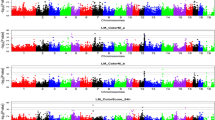Abstract
Meat quality traits have economically significant impacts on the pig industry, and can be improved using molecular approaches in pig breeding. Since 1994 when the first genome-wide scan for quantitative trait loci (QTLs) in pig was reported, over the past two decades, numerous QTLs have been identified for meat quality traits by family based linkage analyses. However, little is known about the genetic variants for meat quality traits in Chinese purebred or outbred populations. To unveil it, we performed a genome-wide association study for 10 meat quality traits in Chinese purebred Laiwu pigs. In total, 75 significant SNPs (P < 1.01 × 10−6) and 33 suggestive SNPs (P < 2.03 × 10−5) were identified. On SSC12, a region between 56.22 and 61.49 Mb harbored a cluster of SNPs that were associated with meat color parameters (L*, lightness; a*, redness; b*, yellowness) and moisture content of longissimus muscle (LM) and semimembranosus muscle at the genome-wide significance level. A region on SSC4 also has pleiotropic effects on moisture content and drip loss of LM. In addition, this study revealed at least five novel QTLs and several candidate genes including 4-linked MYH genes (MYH1, MYH2, MYH3, and MYH13), MAL2, LPAR1, and PRKAG3 at four significant loci. Except for the SSC12 QTL, other QTLs are likely tissue-specific. These results provide new insights into the genetic basis of meat quality traits in Chinese Laiwu pigs and some significant SNPs reported here could be incorporated into the selection programs involving this breed.



Similar content being viewed by others
References
Andersson L, Haley CS, Ellegren H, Knott SA, Johansson M, Andersson K, Andersson-Eklund L, Edfors-Lilja I, Fredholm M, Hansson I et al (1994) Genetic mapping of quantitative trait loci for growth and fatness in pigs. Science 263:1771–1774
Aulchenko YS, Ripke S, Isaacs A, van Duijn CM (2007) GenABEL: an R library for genome-wide association analysis. Bioinformatics 23:1294–1296
Aziziyeh AI, Li TT, Pape C, Pampillo M, Chidiac P, Possmayer F, Babwah AV, Bhattacharya M (2009) Dual regulation of lysophosphatidic acid (LPA1) receptor signalling by Ral and GRK. Cell Signal 21:1207–1217
Barrett JC, Fry B, Maller J, Daly MJ (2005) Haploview: analysis and visualization of LD and haplotype maps. Bioinformatics 21:263–265
Becker D, Wimmers K, Luther H, Hofer A, Leeb T (2013) A genome-wide association study to detect QTL for commercially important traits in Swiss large white boars. PLoS One 8:e55951
Berg EP (2006) Pork composition and quality assessment procedures, 1st edn. National Pork Producer Council (NPPC) Des Moines, IA, USA
Bradbury PJ, Zhang Z, Kroon DE, Casstevens TM, Ramdoss Y, Buckler ES (2007) TASSEL: software for association mapping of complex traits in diverse samples. Bioinformatics 23:2633–2635
Breslow NE, Clayton DG (1993) Approximate inference in generalized linear mixed models. J Am Stat Assoc 88(421):9–25
Ciobanu D, Bastiaansen J, Malek M, Helm J, Woollard J, Plastow G, Rothschild M (2001) Evidence for new alleles in the protein kinase adenosine monophosphate-activated gamma(3)-subunit gene associated with low glycogen content in pig skeletal muscle and improved meat quality. Genetics 159:1151–1162
de Marco MC, Martin-Belmonte F, Kremer L, Albar JP, Correas I, Vaerman JP, Marazuela M, Byrne JA, Alonso MA (2002) MAL2, a novel raft protein of the MAL family, is an essential component of the machinery for transcytosis in hepatoma HepG2 cells. J Cell Biol 159:37–44
Druet T, Farnir FP (2011) Modeling of identity-by-descent processes along a chromosome between haplotypes and their genotyped ancestors. Genetics 188:409–419
Druet T, Georges M (2010) A hidden markov model combining linkage and linkage disequilibrium information for haplotype reconstruction and quantitative trait locus fine mapping. Genetics 184:789–798
Duan YY, Ma JW, Yuan F, Huang LB, Yang KX, Xie JP, Wu GZ, Huang LS (2009) Genome-wide identification of quantitative trait loci for pork temperature, pH decline, and glycolytic potential in a large-scale White Duroc x Chinese Erhualian resource population. J Anim Sci 87:9–16
Fan B, Onteru SK, Du ZQ, Garrick DJ, Stalder KJ, Rothschild MF (2011) Genome-wide association study identifies Loci for body composition and structural soundness traits in pigs. PLoS One 6:e14726
Fujii J, Otsu K, Zorzato F, de Leon S, Khanna VK, Weiler JE, O’Brien PJ, MacLennan DH (1991) Identification of a mutation in porcine ryanodine receptor associated with malignant hyperthermia. Science 253:448–451
Gallardo D, Pena RN, Quintanilla R, Ramirez O, Almuzara D, Noguera JL, Amills M (2012) Quantitative trait loci analysis of a Duroc commercial population highlights differences in the genetic determination of meat quality traits at two different muscles. Anim Genet 43:800–804
Herault F, Vincent A, Dameron O, Le Roy P, Cherel P, Damon M (2014) The longissimus and semimembranosus muscles display marked differences in their gene expression profiles in pig. PLoS One 9:e96491
Kim KS, Larsen N, Short T, Plastow G, Rothschild MF (2000) A missense variant of the porcine melanocortin-4 receptor (MC4R) gene is associated with fatness, growth, and feed intake traits. Mamm Genome 11:131–135
Lee KT, Lee YM, Alam M, Choi BH, Park MR, Kim KS, Kim TH, Kim JJ (2012) A whole genome association study on meat quality traits using high density SNP Chips in a cross between Korean native pig and landrace. Asian Aust J Anim Sci 25:1529–1539
Leinwand LA, Fournier RE, Nadal-Ginard B, Shows TB (1983) Multigene family for sarcomeric myosin heavy chain in mouse and human DNA: localization on a single chromosome. Science 221:766–769
Luo W, Cheng D, Chen S, Wang L, Li Y, Ma X, Song X, Liu X, Li W, Liang J, Yan H, Zhao K, Wang C, Wang L, Zhang L (2012) Genome-wide association analysis of meat quality traits in a porcine large white x Minzhu intercross population. Int J Biol Sci 8:580–595
Ma J, Ren J, Guo Y, Duan Y, Ding N, Zhou L, Li L, Yan X, Yang K, Huang L, Song Y, Xie J, Milan D, Huang L (2009) Genome-wide identification of quantitative trait loci for carcass composition and meat quality in a large-scale white duroc x Chinese Erhualian resource population. Anim Genet 40:637–647
Ma J, Yang J, Zhou L, Zhang Z, Ma H, Xie X, Zhang F, Xiong X, Cui L, Yang H, Liu X, Duan Y, Xiao S, Ai H, Ren J, Huang L (2013) Genome-wide association study of meat quality traits in a white duroc x Erhualian F2 intercross and Chinese Sutai pigs. PLoS One 8:e64047
Ma J, Yang J, Zhou L, Ren J, Liu X, Zhang H, Yang B, Zhang Z, Ma H, Xie X, Xing Y, Guo Y, Huang L (2014) A splice mutation in the PHKG1 gene causes high glycogen content and low meat quality in pig skeletal muscle. PLoS Genet 10:e1004710
Milan D, Jeon JT, Looft C, Amarger V, Robic A, Thelander M, Rogel-Gaillard C, Paul S, Iannuccelli N, Rask L, Ronne H, Lundstrom K, Reinsch N, Gellin J, Kalm E, Roy PL, Chardon P, Andersson L (2000) A mutation in PRKAG3 associated with excess glycogen content in pig skeletal muscle. Science 288:1248–1251
Moolenaar WH, Kranenburg O, Postma FR, Zondag GC (1997) Lysophosphatidic acid: G-protein signalling and cellular responses. Curr Opin Cell Biol 9:168–173
Nonneman DJ, Shackelford SD, King DA, Wheeler TL, Wiedmann RT, Snelling WM, Rohrer GA (2013) Genome-wide association of meat quality traits and tenderness in swine. J Anim Sci 91:4043–4050
Oldfors A, Tajsharghi H, Darin N, Lindberg C (2004) Myopathies associated with myosin heavy chain mutations. Acta Myol 23:90–96
Otto G, Roehe R, Looft H, Thoelking L, Knap PW, Rothschild MF, Plastow GS, Kalm E (2007) Associations of DNA markers with meat quality traits in pigs with emphasis on drip loss. Meat Sci 75:185–195
Pearson TA, Manolio TA (2008) How to interpret a genome-wide association study. JAMA 299:1335–1344
Ponsuksili S, Murani E, Trakooljul N, Schwerin M, Wimmers K (2014) Discovery of candidate genes for muscle traits based on GWAS supported by eQTL-analysis. Int J Biol Sci 10:327–337
Purcell S, Neale B, Todd-Brown K, Thomas L, Ferreira MA, Bender D, Maller J, Sklar P, de Bakker PI, Daly MJ, Sham PC (2007) PLINK: a tool set for whole-genome association and population-based linkage analyses. Am J Hum Genet 81:559–575
Ramos AM, Crooijmans RP, Affara NA, Amaral AJ, Archibald AL, Beever JE, Bendixen C, Churcher C, Clark R, Dehais P, Hansen MS, Hedegaard J, Hu ZL, Kerstens HH, Law AS, Megens HJ, Milan D, Nonneman DJ, Rohrer GA, Rothschild MF, Smith TP, Schnabel RD, Van Tassell CP, Taylor JF, Wiedmann RT, Schook LB, Groenen MA (2009) Design of a high density SNP genotyping assay in the pig using SNPs identified and characterized by next generation sequencing technology. PLoS One 4:e6524
Rassmussen AJ, Andersson M (1996) New method for determination of drip loss in pork muscles. In: Proceedings 42nd international congress of meat science and technology. Lillehmmer, Norway, pp 286–287
Ren J, Duan Y, Qiao R, Yao F, Zhang Z, Yang B, Guo Y, Xiao S, Wei R, Ouyang Z, Ding N, Ai H, Huang L (2011) A missense mutation in PPARD causes a major QTL effect on ear size in pigs. PLoS Genet 7:e1002043
Riquet J, Gilbert H, Servin B, Sanchez MP, Iannuccelli N, Billon Y, Bidanel JP, Milan D (2011) A locally congenic backcross design in pig: a new regional fine QTL mapping approach miming congenic strains used in mouse. BMC Genet 12:6
Rosenvold K, Andersen HJ (2003) Factors of significance for pork quality-a review. Meat Sci 64:219–237
Rothschild M, Bidanel JP (2002) Current status of quantitative trait locus mapping in pigs. Pig News Inf 23:39N–54N
Ryan MT, Hamill RM, O’Halloran AM, Davey GC, McBryan J, Mullen AM, McGee C, Gispert M, Southwood OI, Sweeney T (2012) SNP variation in the promoter of the PRKAG3 gene and association with meat quality traits in pig. BMC Genet 13:66
Sanchez MP, Riquet J, Iannuccelli N, Gogue J, Billon Y, Demeure O, Caritez JC, Burgaud G, Feve K, Bonnet M, Pery C, Lagant H, Le Roy P, Bidanel JP, Milan D (2006) Effects of quantitative trait loci on chromosomes 1, 2, 4, and 7 on growth, carcass, and meat quality traits in backcross Meishan x large white pigs. J Anim Sci 84:526–537
Sanchez MP, Tribout T, Iannuccelli N, Bouffaud M, Servin B, Tenghe A, Dehais P, Muller N, Del Schneider MP, Mercat MJ, Rogel-Gaillard C, Milan D, Bidanel JP, Gilbert H (2014) A genome-wide association study of production traits in a commercial population of large white pigs: evidence of haplotypes affecting meat quality. Genet Sel Evol 46:12
Sartelet A, Druet T, Michaux C, Fasquelle C, Geron S, Tamma N, Zhang Z, Coppieters W, Georges M, Charlier C (2012) A splice site variant in the bovine RNF11 gene compromises growth and regulation of the inflammatory response. PLoS Genet 8:e1002581
Skarnes WC, Rosen B, West AP, Koutsourakis M, Bushell W, Iyer V, Mujica AO, Thomas M, Harrow J, Cox T, Jackson D, Severin J, Biggs P, Fu J, Nefedov M, de Jong PJ, Stewart AF, Bradley A (2011) A conditional knockout resource for the genome-wide study of mouse gene function. Nature 474:337–342
Stratz P, Wellmann R, Preuss S, Wimmers K, Bennewitz J (2014) Genome-wide association analysis for growth, muscularity and meat quality in Pietrain pigs. Anim Genet 45:350–356
Suzuki K, Irie M, Kadowaki H, Shibata T, Kumagai M, Nishida A (2005) Genetic parameter estimates of meat quality traits in Duroc pigs selected for average daily gain, longissimus muscle area, backfat thickness, and intramuscular fat content. J Anim Sci 83:2058–2065
Toydemir RM, Rutherford A, Whitby FG, Jorde LB, Carey JC, Bamshad MJ (2006) Mutations in embryonic myosin heavy chain (MYH3) cause freeman–sheldon syndrome and Sheldon–Hall syndrome. Nat Genet 38:561–565
Uimari P, Sironen A (2014) A combination of two variants in PRKAG3 is needed for a positive effect on meat quality in pigs. BMC Genet 15:29
Van Laere AS, Nguyen M, Braunschweig M, Nezer C, Collette C, Moreau L, Archibald AL, Haley CS, Buys N, Tally M, Andersson G, Georges M, Andersson L (2003) A regulatory mutation in IGF2 causes a major QTL effect on muscle growth in the pig. Nature 425:832–836
Wellcome Trust Case Control C (2007) Genome-wide association study of 14,000 cases of seven common diseases and 3,000 shared controls. Nature 447:661–678
Yang Q, Cui J, Chazaro I, Cupples LA, Demissie S (2005) Power and type I error rate of false discovery rate approaches in genome-wide association studies. BMC Genet 6(Suppl 1):S134
Yu J, Pressoir G, Briggs WH, Vroh Bi I, Yamasaki M, Doebley JF, McMullen MD, Gaut BS, Nielsen DM, Holland JB, Kresovich S, Buckler ES (2006) A unified mixed-model method for association mapping that accounts for multiple levels of relatedness. Nat Genet 38:203–208
Zhang F, Zhang Z, Yan X, Chen H, Zhang W, Hong Y, Huang L (2014) Genome-wide association studies for hematological traits in Chinese Sutai pigs. BMC Genet 15:41
Acknowledgments
This research was supported by the Key Project of National Nature Science Foundation of China (No. 31230069), the Development Programs for Basic Research of China (973 Programs, Nos. 2012CB722502 and 2012CB124702) and National High-Tech Research and Development Program of China (2013AA102502).
Conflict of interest
The authors declare that they have no conflict of interest.
Author information
Authors and Affiliations
Corresponding authors
Additional information
Xinwei Xiong and Xianxian Liu have contributed equally to this work.
Electronic supplementary material
Below is the link to the electronic supplementary material.
Rights and permissions
About this article
Cite this article
Xiong, X., Liu, X., Zhou, L. et al. Genome-wide association analysis reveals genetic loci and candidate genes for meat quality traits in Chinese Laiwu pigs. Mamm Genome 26, 181–190 (2015). https://doi.org/10.1007/s00335-015-9558-y
Received:
Accepted:
Published:
Issue Date:
DOI: https://doi.org/10.1007/s00335-015-9558-y




